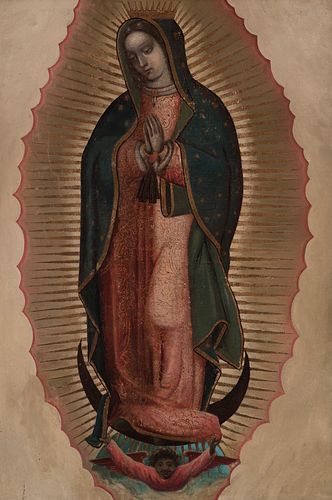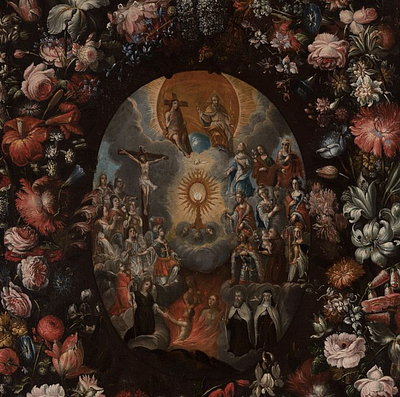Novo-Hispanic school; XVIII century. "Guadalupana". Oil on canvas.
Lot 96
About Seller
Setdart Auction House
Carrer Aragó 346
Barcelona
Spain
Setdart Subastas was born in 2004 and is currently the first online art auction in Spain with solidity, prestige and reliability guaranteed by our more than 60,000 users. Setdart has a young, dynamic and enterprising team ready to successfully manage the purchase and sale of art works through custom...Read more
Estimate:
EUR€5,000 - EUR€6,000
$5,376.34 - $6,451.61
Absentee vs Live bid
Two ways to bid:
- Leave a max absentee bid and the platform will bid on your behalf up to your maximum bid during the live auction.
- Bid live during the auction and your bids will be submitted real-time to the auctioneer.
Bid Increments
| Price | Bid Increment |
|---|---|
| EUR€0 | EUR€10 |
| EUR€200 | EUR€25 |
| EUR€500 | EUR€50 |
| EUR€1,000 | EUR€100 |
| EUR€3,000 | EUR€200 |
| EUR€5,000 | EUR€500 |
| EUR€10,000 | EUR€1,000 |
| EUR€20,000 | EUR€2,000 |
| EUR€50,000 | EUR€5,000 |
About Auction
By Setdart Auction House
Jul 14, 2021
Set Reminder
2021-07-14 06:30:00
2021-07-14 06:30:00
America/New_York
Bidsquare
Bidsquare : OLD MASTERS
https://www.bidsquare.com/auctions/setdart-auction-house/old-masters-7202
Setdart Auction House sofia@setdart.com
Setdart Auction House sofia@setdart.com
- Lot Description
Novo-Hispanic school; XVIII century. "Guadalupana". Oil on canvas. Presents period frame with damage and repainting. Size: 98 x 65 cm; 119 x 89 cm (frame). The iconography of Guadalupe acquired great richness and variety especially from the seventeenth century. The representation that concerns us follows faithfully that of the original canvas (attributed to the Indian Marcos Cípac, XVI century): the crescent moon at her feet supported by an angel, the rays bordering the figure, the mandorla, the crown, the dark complexion of the Virgin... Our Lady of Guadalupe is a Marian invocation of the Catholic Church, whose image has its main center of worship in the Basilica of Guadalupe, in the north of Mexico City. According to Mexican oral tradition, it is believed that the Virgin Mary appeared four times to Saint Juan Diego Cuauhtlatoatzin on the hill of Tepeyac. Juan Diego, in the last apparition of the Virgin, carried in his ayate some flowers that he cut on Tepeyac, according to the Virgin's order. He unfolded his ayate before Bishop Juan de Zumárraga, revealing the image of the Virgin Mary, dark and with mestizo features. The Mesoamerican peoples from remote times already venerated in the hill of Tepeyac a deity called Tonantzin, hence there is a certain syncretism with the assimilation of the message brought by the Virgin Mary. This event was known as the Miracle of the Roses, and was recorded in the "Nican Mopohua", a text presumably written by the Indian Antonio Valeriano. It is worth mentioning that during the Spanish colonial domination, a mainly religious painting was developed, aimed at Christianizing the indigenous peoples. The local painters were modeled on Spanish works, which they followed literally in terms of types and iconography. The most frequent models were the harquebusier angels and the triangular virgins, however, it was not until the first years of the 19th century, already in times of independence and political opening of some of the colonies, that several artists began to represent a new model of painting with its own identity.
- Shipping Info
-
In-house shipping available. Please inquire at admin@setdart.com.
-
- Buyer's Premium



 EUR
EUR CAD
CAD AUD
AUD GBP
GBP MXN
MXN HKD
HKD CNY
CNY MYR
MYR SEK
SEK SGD
SGD CHF
CHF THB
THB

















